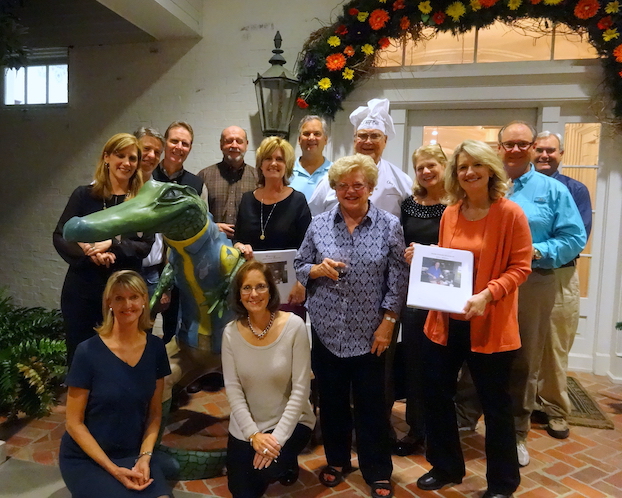Son makes good on cassoulet promise eight years later
Published 8:42 am Wednesday, May 4, 2022

- Eight years ago, Bill Shaddock’s cooking school students said they wanted to return the favor of making a cassoulet. A couple of weeks ago, Steve Shaddock and two friends finally made good on that offer. (Special to the American Press)
Popular Chef Ina Garten, The Barefoot Contessa, is well known for her expertise in the kitchen. Her cookbooks have sold over six million copies. The one food challenge she chooses not to undertake is cassoulet. The dish was developed in medieval times and allowed peasants to make do with what was available, which in that part of France during that time was dried beans, preserved duck and preserved pork. Cassoulet is labor and time intensive. It takes three days to prepare and five to six actual hours of cooking time.
William “Bill” Shaddock had no such reservations about conquering the cassoulet, or for that matter the souffle or any other Francais entree, and the local gourmet has passed his passion to two of his three children.
“Anyone who can read can learn to cook,” Shaddock said, as great cooks often assure skeptics with fine reading skills who may turn out a fine dish one day and a dud the next.
Trending
It was Shaddock’s stepfather Stephen Eugene Plauché who piqued his interest in cooking. Plauché married his mother, Edith Burton Shaddock, when Bill was 12.
“He would come home from his office, usually around four o’clock and start cooking,” Shaddock said, “and I’d sit down and watch him and learn.”
It wasn’t long until Shaddock began delving into more complex dishes and doing dinner on his own. In his collection of recipes, A View from Bill’s Kitchen, he wrote, “Some turned out good and some not so good! But I was hooked on cooking.”
After retirement from his law practice in 2014, Shaddock hosted a French cooking school for 13 adults, including his three children Nancy, Mary and Stephen. It was dubbed the Le Cordon Bill School. Graduates received the Le Cardon Bill cooking certification.
“My first thought, after 13 people wanted to come to the class, within an hour of putting the idea out there to gage interest, I thought if I’m going to have a cooking school, I’ll need a lesson plan and recipes, so I developed this,” he said. He pushed a notebook across the table titled “From Stocks to Sauces.” Inside were 50 typed pages outlining the lessons for the once-a-week, 12-week program.
“I started with chicken stock. The next class we made a veloute (vuh-loo-TAY) using the stock,” he said.
Trending
Veloute and four other French sauces serve as a starting point for a variety of delicious dishes. Classes culminated with Grand Marnier souffles drizzled with Grand Marnier vanilla sauce. The vanilla sauce was flavored with a vanilla bean.
About mid-point through his cooking school, Shaddock decided to treat the class to a cassoulet based mostly on a Julia Child recipe.
“They just raved over it, and said we’ve got to do this again. We’re going to make this for you “Mr. B.” So, I said yeah, sure.”
Eight years later, Bill’s son Steve made good on that promise with help from friends Mark Hanudel and Jim Perry.
“I don’t have anything bad to say about any of them but I will say that the first attempt might not have been a home run. I’ll just stop there,” he said with a deep chuckle.
Pressed for more information, Shaddock said the dish was was awful, dry and lacked flavor.
“It wasn’t that bad,” his wife Craig chided him.
“Oh, it was that bad,” Shaddock assured.
Steve Shaddock, Hanudel and Perry do not take their culinary reputations lightly. They went back to the cutting board.
On day 1, they started from scratch, deboning ducks. On day 3, the cassoulet came out of the oven, the breadcrumb crust was broken with the back of a spoon to open a hole, reserved liquids were added and the dish was sprinkled with breadcrumbs and parsley and cooked for its final 10 minutes. A food torch crisped the topping again – lightly – and the three men pronounced it done.
“They improved the recipe immensely,” Shaddock said. “For one thing, they made their own duckling confit (kown-fee) using a sous vide (sue-veed) machine,” he said.
Confit means preserved in French. The preservation is due to the air-blocking seal formed by the rendered fat in which the duck is submerged and then cooked.
The sous vide method cooks food slowly in a temperature controlled water bath using an immersion circulator.
This Child, Shaddock, Shaddock, Hanudel, Perry cassoulet included slow-cooked pork shoulder, pot-roasted lamb with demi-glace (a brown stock reduced by prolonged simmering combined with Espagnole sauce – another one of those “classic mother sauces of French cuisine”), cannellini beans and a crusty covering of Italian breadcrumbs browned in duck fat and mixed with a cup of minced Italian parsley.
“It had layers and layers of flavors,” Craig said. The sausage cakes flavored with cognac, all-spice and garlic were especially delicious.”
After an earlier conversation filled with friendly banter about how his son stole all his recipes and put his name on them, in the kitchen he designed himself, seated at a table that held a large jar of “Big Dad’s Seasoning,” – his own recipe and it’s in Pirate’s Pantry – Bill Shaddock seemed proud to pass the food torch to his son. Why shouldn’t he enjoy his enviable new role as chief taster and food critic.




